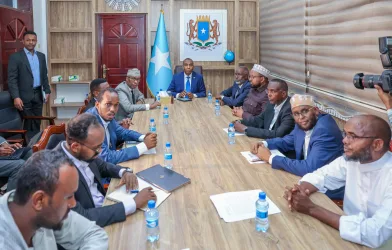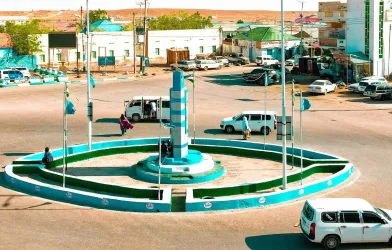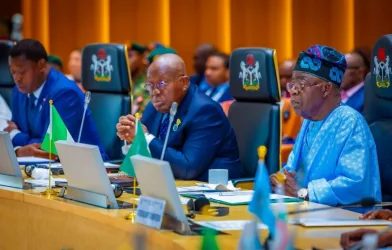
The current diplomatic crisis bedeviling the relationship between Somalia and Kenya is a paradox; it is both unstoppable and unsustainable!
The diplomatic rift sadly comes at a time when both countries are facing strong social and economic headwinds as a result of the COVID-19 pandemic. The rift also comes at a time when the hegemony of EPRDF and the Tigrayan People’s Liberation Front in Ethiopia has come to an abrupt end, following uncontested rule for three decades. These, and other events, have fostered greater instability across the Horn of Africa with direct and spillover for both Somalia and Kenya, but also for Djibouti, Eritrea and Egypt.
Of course, given the evolving militarization of the Red Sea, from Socotra Island to the new Neom City, the relationship between the Horn of Africa and Gulf States has never been strategically more important. The Gulf States played a key role in brokering the peace deal between Ethiopia and Eritrea; in return for an oil pipeline to counter declining western markets and to reduce Ethiopia’s energy deficit. At the same time, the internal fractures within the Gulf Cooperation Council (GCC) following splits over Egypt and the Muslim Brotherhood, has had significant repercussions for Somalia; at a time when unified regional support was vital to stabilize its fledgling federal democracy.
But before looking forward to resolution; both states must first look backwards to understand the rationale and motivation of the other; as an essential ingredient of any grand bargain.
As a result of colonialism in the Horn of Africa, Kenya and Somalia inherited complex borderland-governance arrangements between both countries. These arrangements papered over the common ancestry that now administratively divides the North Eastern Province of Kenya from the Southern Somali State of Jubaland. A parallel example might be the 1919 Durand Line that divided the ethnic Pashtun community between Pakistan and Afghanistan; creating a de facto borderland that continues to be essentially ungovernable.
Of course, borderlands generally don’t matter until there are claims at stake; and this is where the current crisis becomes increasingly complex. Both sides stake claims on their own security and (depending on points of view and interests) also on the 100,000 square kilometers of maritime territory currently being decided upon by the International Court of Justice at The Hague. While the final determination of maritime boundaries will be left to the court, the maritime border dispute has already divided the international community. With billions of dollars potentially on the table, and with security concerns continuing to bedevil stability, Somalia now has the ability to reassert its sovereignty following an absence of many decades, and to forge a path to a viable state.
This current rift therefore has very deep roots; with both sides’ prima facie appearing to have strong grounds for divorce.
For Kenya, the 2013 attack on the Westgate Mall claim by Al-Shabaab, encouraged the government to adopt a more forward foreign policy towards Somalia. This attack was followed by the 2016 Battle of El Adde in which up to 151 Kenyan Defense Forces supporting the African Union Mission to Somalia (AMISOM) were slaughtered by Al-Shabaab, marking the deadliest day in Kenyan military history. In 2019, the attack on the DusitD2 Complex in Nairobi – also claimed by Al-Shabab – killed 21, including the six attackers. Al-Shabaab of course attacks both the Somali and Kenyan governments, and unless Somalia is able to reclaim and exploit its economy for fiscal gain, such attacks are sure to continue. Despite these attacks, in recent times diplomatic relations have been thawing, signaled in late 2018 by Kenya Airways announcing direct flights between Nairobi and Mogadishu. Indeed, the appointment of my two esteemed Kenyan colleagues to the Somalia National Economic Council (NEC), were in many ways part of that increasing openness.
For Somalia of course, the new Federal Government is keen to make sure that Somalia does not balkanize; which is entirely possible. Somalia has already suffered intolerable losses and indignity. At the turn of the last century, the North Eastern Province territory was already carved out of present-day southern Somalia and handed to Kenya, despite being inhabited by Ethnic Somalis. Somaliland, Puntland and Jubaland already claim either full or partial autonomy and the risk of further fragmentation would undermine the stability of the entire Horn, including in Kenya.
In order to understand Somalia, one must understand the historical roots behind the concept of Greater Somalia (or so-called pan Somaliism), which began to emerge early in the 20th century and ultimately led to the Ogaden war in 1977. The conceptual territory of Greater Somalia historically encompassed British Somaliland, Italian Somaliland, French Somaliland (now Djibouti), the Somali Region in the Ethiopian Empire and the former Northern Frontier District in the Colony and Protectorate of Kenya. On the 26th of June 1960, the British government even declared that all Somali-inhabited areas of East Africa, what would be Greater Somalia, should be unified in one administrative region. Yet, that never happened, though the influence of ethnic Somali’s across the Horn of Africa remains undeniable.
As a result of fragmentation and collapse of Somali state in 1991, Somalis have in many ways been made to feel like second-class citizens in the Horn of Africa; for reasons that were substantially not of their own making. The consequence of the collapse of state has led to widespread insecurity, famine, drought and an inability to re-assert its own sovereignty and as a consequence, to play a more active role in promoting regional security and integration. With the Federal Government continuing to rely on financial support from the international community, the newly established Federal Government has no choice but to secure a path towards self-reliance; and sovereign integrity and fiscal sustainability are central to that pursuit.
While the current crisis perhaps just reflects regional growing pains as Somalia reclaims its seat at the table, both Kenya and Somalia have more to gain from collaborating, than antagonizing. If Somalia cannot secure and police its borders – because its fiscal dispensation keeps it in the pockets of other nations – at some point collapse would surely follow and the impact would spin out across the Horn; more deeply into Kenya. Far better to continue to work to build a viable state, to understand each other’s historical misgivings and wrongdoings, to reconcile differences, to make the multi-billion-dollar African Union Horn of Africa Initiative a chain of prosperity by opening up the flood gates to capital from the Gulf States, Turkey and China. If we are the people we have been waiting for, and both societies are already too integrated to be untangled, diplomacy, dialogue and regional integration must simply prevail.
Article Submitted by Dr. Peter J. Middlebrook, Member of the Somalia National Economic Council (NEC), Former World Bank, EU and UK Government Economist, CEO of Geopolicity Inc. and Dignity Designed and Delivered Inc.







